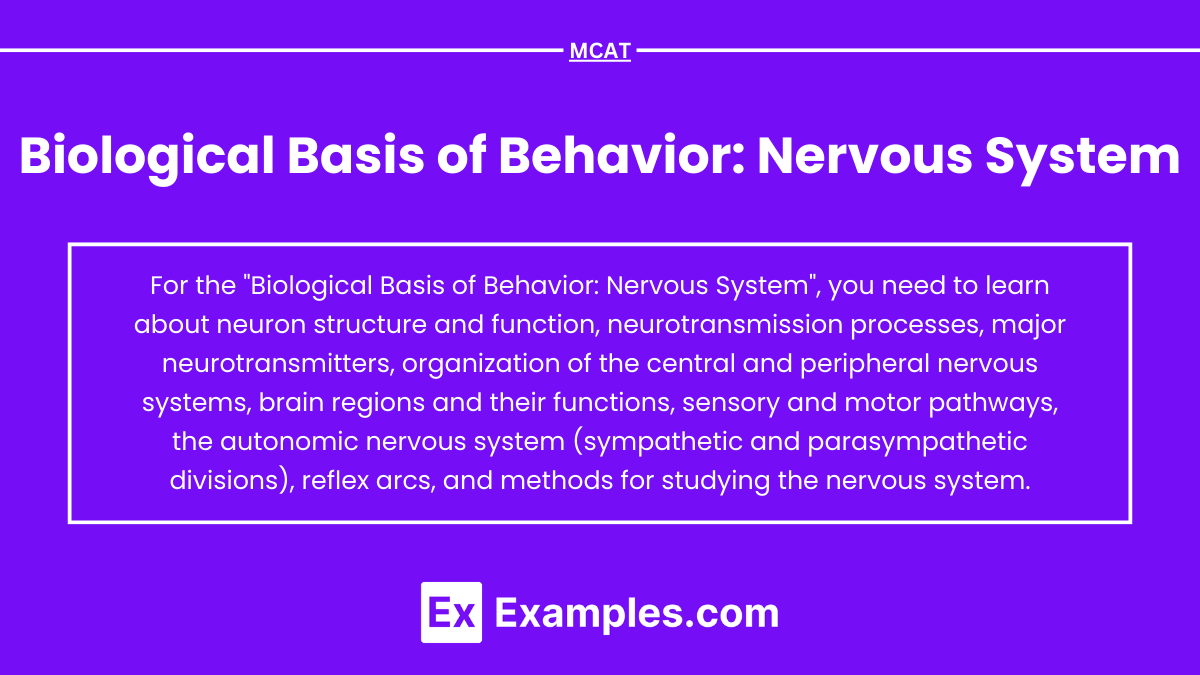The biological basis of behavior, particularly through the nervous system, is central to understanding how physical structures and biochemical processes influence human actions and cognition. This topic covers the anatomy and function of the central and peripheral nervous systems, detailing how neurons communicate through electrical and chemical signals to produce complex behaviors. It also examines neurotransmitters and hormones, which play critical roles in mood, learning, and stress responses.
Learning Objectives
In studying the "Biological Basis of Behavior: Nervous System" for the MCAT, you should understand the structure and function of the nervous system, including the roles of neurons, synapses, neurotransmitters, and key brain regions. Analyze how the central and peripheral nervous systems coordinate sensory input, motor responses, and autonomic functions. Evaluate the biological mechanisms behind behaviors, such as reflex arcs, memory, learning, and emotional regulation. Additionally, explore how neurotransmitter imbalances contribute to psychological disorders. Apply your understanding to interpreting experimental results, particularly in passages involving nervous system functions, neurological diseases, and drug effects on synaptic transmission.
1. Overview of the Nervous System
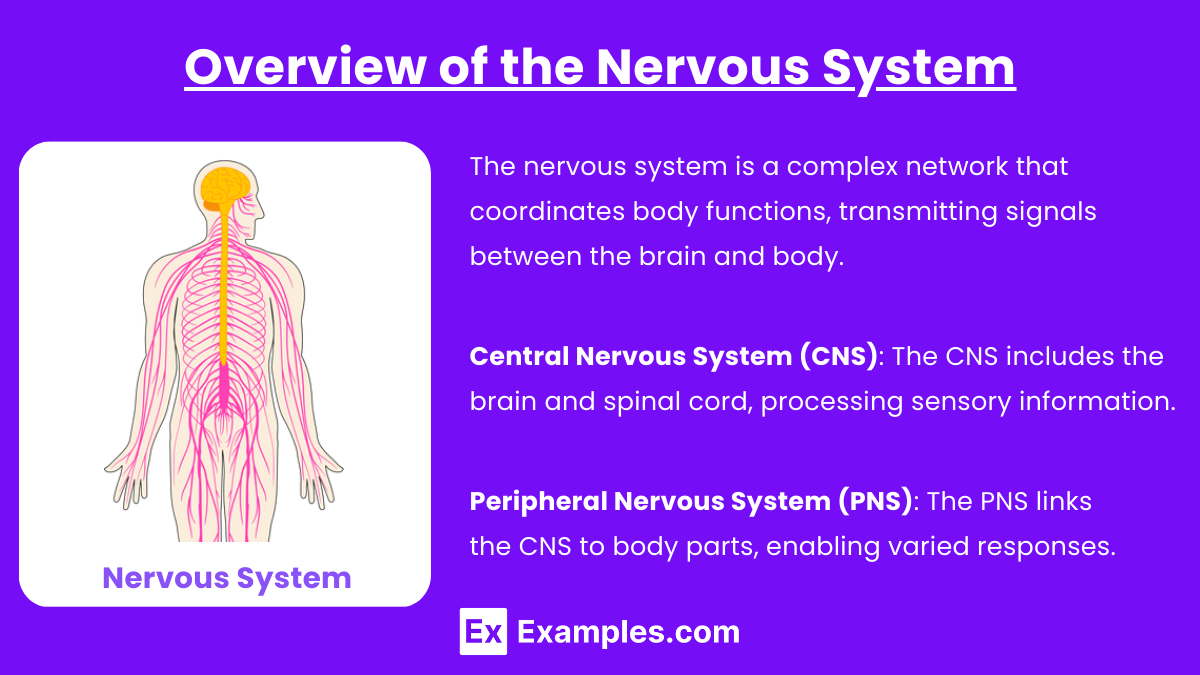
The nervous system is a complex network responsible for coordinating all the body's activities. It allows organisms to perceive, process, and respond to internal and external stimuli. Understanding the nervous system is crucial for the MCAT, particularly in the context of the Biological Basis of Behavior.
Central Nervous System (CNS): Comprised of the brain and spinal cord, the CNS processes, interprets, and responds to sensory information. The brain's various regions are responsible for different functions, while the spinal cord conducts signals to and from the brain, coordinating reflexes and bodily movements.
Peripheral Nervous System (PNS): Divided into the somatic and autonomic nervous systems, the PNS connects the CNS to limbs and organs, facilitating voluntary and involuntary responses. The autonomic system is further split into the sympathetic (fight-or-flight response) and parasympathetic (rest-and-digest) branches, regulating homeostasis and emergency responses.
2. Neurons: The Basic Units of the Nervous System

Structure and Function of Neurons: Neurons have a cell body, dendrites (for receiving signals), and an axon (for sending signals). Myelinated axons allow for faster signal transmission due to the myelin sheath’s insulation.
Types of Neurons:
Sensory (afferent) neurons: Carry signals from sensory organs to the CNS.
Motor (efferent) neurons: Transmit signals from the CNS to muscles and glands.
Interneurons: Process information within the CNS, connecting sensory and motor pathways.
3. Neurotransmission
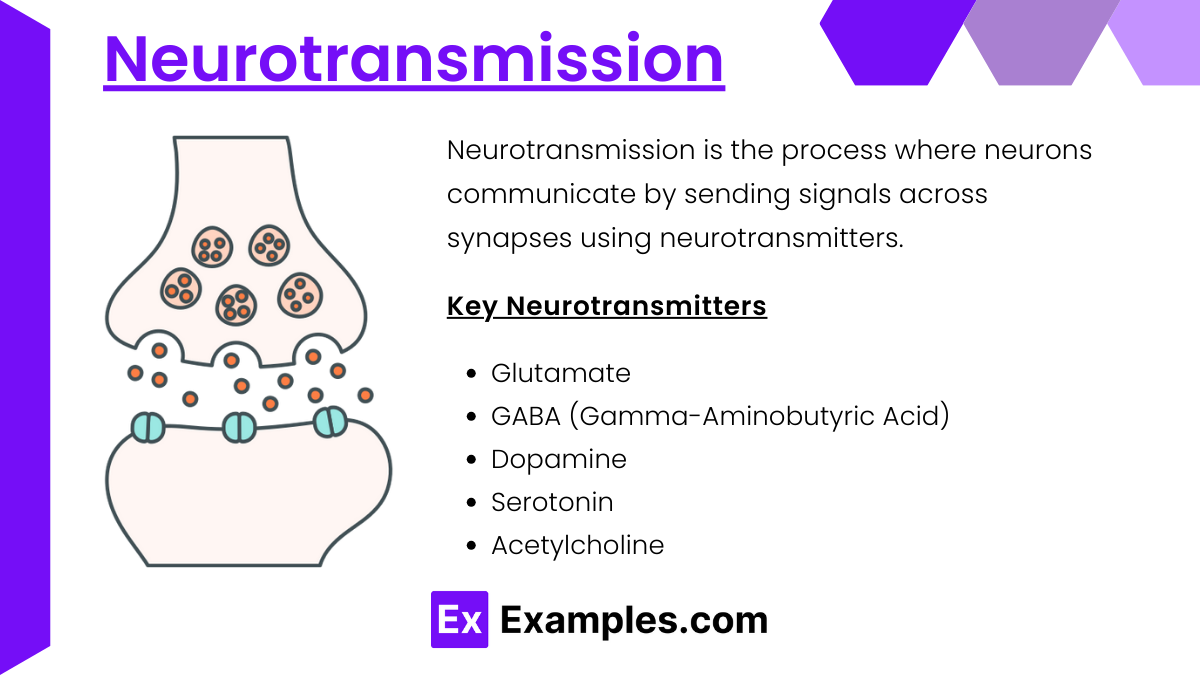
Neurotransmission is the process where neurons communicate by sending signals across synapses using neurotransmitters.
Action Potentials: Electrical impulses that travel along the axon when a neuron is sufficiently stimulated, resulting in the opening of ion channels and movement of Na+ and K+ ions.
Synaptic Transmission: At the synapse, neurotransmitters are released from the axon terminal, cross the synaptic cleft, and bind to receptors on the postsynaptic neuron. This binding can be excitatory or inhibitory, influencing the likelihood of the next neuron firing.
Key Neurotransmitters:
Glutamate: The main excitatory neurotransmitter in the CNS, involved in learning and memory.
GABA (Gamma-Aminobutyric Acid): The main inhibitory neurotransmitter, crucial for reducing neuronal excitability.
Dopamine: Associated with reward, motivation, and motor control; imbalances are linked to Parkinson’s disease and schizophrenia.
Serotonin: Regulates mood, appetite, and sleep, playing a role in depression and anxiety.
Acetylcholine: Facilitates muscle contraction in the PNS and is involved in learning and memory in the CNS.
4. Brain Structures and Their Functions
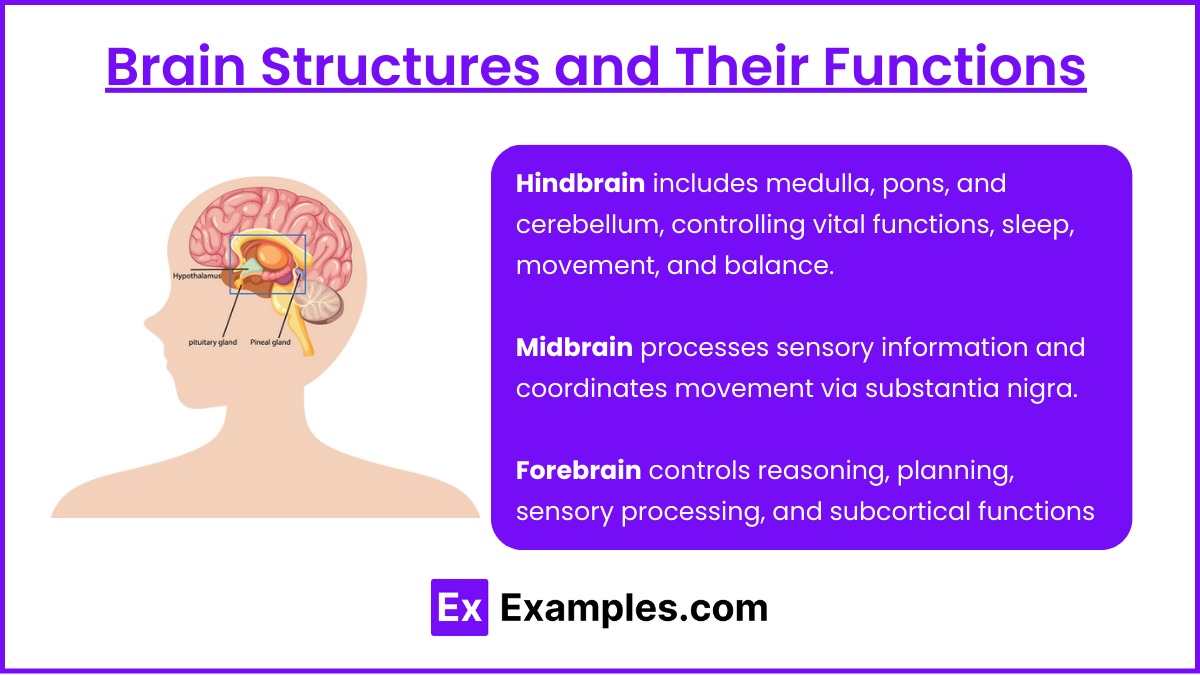
Hindbrain: Comprises the medulla (controls vital functions like breathing and heart rate), pons (regulates sleep and arousal), and cerebellum (coordinates movement and balance).
Midbrain: Important for processing auditory and visual information and coordinating motor responses, with structures like the substantia nigra, which is involved in movement regulation.
Forebrain: Includes the cerebral cortex (responsible for higher functions such as reasoning, planning, and sensory processing) and subcortical structures:
Thalamus: Acts as a relay station, directing sensory information to the cerebral cortex.
Hypothalamus: Regulates vital functions and links the nervous system to the endocrine system via the pituitary gland, influencing behaviors like hunger, thirst, and body temperature.
Limbic System: Involves the amygdala (emotional processing, especially fear and aggression) and hippocampus (formation of new memories).
5. Endocrine System Interaction
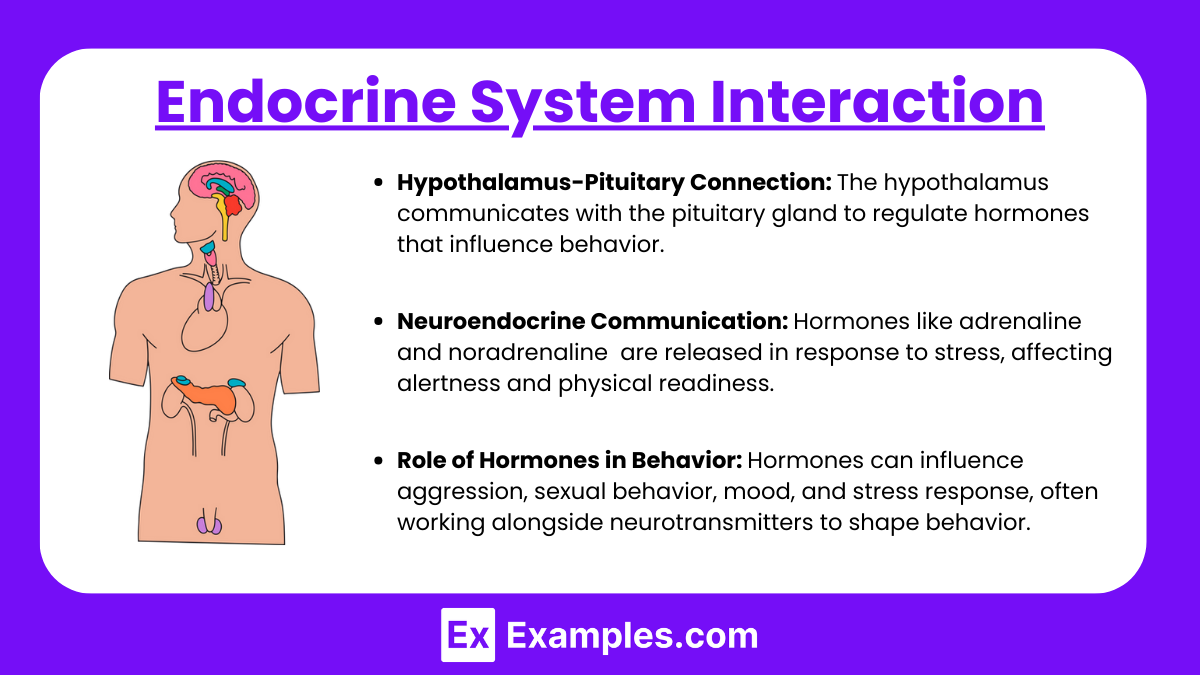
Hypothalamus-Pituitary Connection: The hypothalamus communicates with the pituitary gland to regulate hormones that influence behavior. For example, cortisol (produced by adrenal glands) is involved in stress response.
Neuroendocrine Communication: Hormones like adrenaline (epinephrine) and noradrenaline (norepinephrine) are released in response to stress, affecting alertness and physical readiness.
Role of Hormones in Behavior: Hormones can influence aggression, sexual behavior, mood, and stress response, often working alongside neurotransmitters to shape behavior.
Examples
Example 1: Role of Neurotransmitters in Mood Regulation
Neurotransmitters such as serotonin and dopamine significantly influence mood and emotional responses. For instance, low serotonin levels are associated with depression and anxiety, while dopamine is linked to pleasure and motivation. Drugs targeting these neurotransmitters (e.g., SSRIs for serotonin) are commonly used in treating mood disorders, demonstrating the link between neurochemistry and behavioral health.
Example 2: Sympathetic Nervous System in Stress Response
The sympathetic branch of the autonomic nervous system activates the "fight-or-flight" response in stressful situations. This involves increased heart rate, dilated pupils, and heightened alertness, preparing the body to respond to threats. This example illustrates how the nervous system integrates external stimuli and mobilizes the body for action, an essential adaptation for survival.
Example 3: Reflex Arc and Rapid Responses
Reflex actions, such as the knee-jerk reaction, are controlled by a reflex arc, which bypasses the brain for faster response. Sensory neurons relay the signal directly to motor neurons via interneurons in the spinal cord. This rapid, automatic response helps protect the body from harm, exemplifying the efficiency and adaptability of the nervous system.
Example 4: Cerebellum’s Role in Coordination and Balance
The cerebellum, located in the hindbrain, is responsible for coordinating voluntary movements and maintaining balance. It processes sensory information from the inner ear and muscles, allowing for precise and smooth movement. Damage to the cerebellum can result in ataxia, a condition characterized by loss of coordination, highlighting the cerebellum’s role in motor control.
Example 5: Hypothalamus and Homeostasis
The hypothalamus is a key regulatory center in the brain, maintaining homeostasis by controlling hunger, thirst, temperature, and the endocrine system. It communicates with the pituitary gland to release hormones that influence bodily functions, such as cortisol during stress. This example shows how the nervous system, in conjunction with the endocrine system, manages essential survival functions and behavioral responses.
Practice Questions
Question 1
Which of the following best describes how the sympathetic nervous system can be compared to market behavior in microeconomics?
A) The sympathetic nervous system regulates homeostasis, similar to market equilibrium.
B) The sympathetic nervous system prepares the body for stress, akin to a market responding to external shocks.
C) The sympathetic nervous system slows down body functions, analogous to a recession in a market.
D) The sympathetic nervous system focuses on long-term growth, similar to stable market conditions.
Answer: B) The sympathetic nervous system prepares the body for stress, akin to a market responding to external shocks.
Explanation: The sympathetic nervous system activates the body's "fight-or-flight" response during stressful situations, rapidly mobilizing resources for action. This can be likened to a market responding to external shocks (like natural disasters or sudden economic crises), where quick adjustments are needed to maintain stability or survive. Just as the body adapts to stress, markets adjust supply, demand, and prices in response to sudden external factors.
Question 2
How can neurotransmitters' role in regulating behavior be compared to the concept of marginal utility in microeconomics?
A) Both neurotransmitters and marginal utility diminish over time as more of the same stimulus is encountered.
B) Neurotransmitters and marginal utility both increase steadily without limit.
C) Neurotransmitters regulate short-term decisions, while marginal utility focuses on long-term consumption behavior.
D) Neurotransmitters and marginal utility are both constant regardless of changes in external conditions.
Answer: A) Both neurotransmitters and marginal utility diminish over time as more of the same stimulus is encountered.
Explanation: In both the biological and economic contexts, diminishing returns occur with repeated exposure. For neurotransmitters, continuous stimulation may lead to reduced effects (e.g., tolerance to dopamine-releasing activities). Similarly, in microeconomics, marginal utility decreases as a consumer receives more of the same good, reflecting a reduced additional satisfaction with each additional unit consumed. Both concepts highlight how the initial impact diminishes over time.
Question 3
In the context of homeostasis maintained by the hypothalamus, which microeconomic principle is most comparable?
A) The concept of diminishing returns.
B) The idea of market equilibrium.
C) The law of supply and demand.
D) The concept of consumer surplus.
Answer: B) The idea of market equilibrium.
Explanation: The hypothalamus maintains homeostasis in the body by regulating internal conditions like temperature, hunger, and hormone levels, ensuring balance. This is similar to the concept of market equilibrium in microeconomics, where the market adjusts the quantity supplied and demanded to maintain a balance at a particular price level. In both cases, the goal is to maintain stability—whether in biological systems or economic markets.

